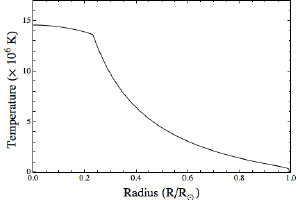Post
Building a
Better Star
23 March 2012
In an earlier post I talked about a very simple model of a star consisting simply of a mass of hydrogen and helium held together by gravity. The simple model ignored some important stellar properties such as the fact that stars radiate light and undergo nuclear fusion in their cores. So it wasn’t surprising that our model predicted a core temperature for the sun that was too cool by a factor of 100. But even this simple model demonstrated that the temperature and pressure of the sun is high enough to undergo nuclear fusion.
So how could we revise our model? In turns out we can calculate the rate of energy produced by hydrogen fusion given a particular temperature, density, etc. So we can calculate the rate at which energy is produced at a given depth and include that in our model. We also have to account for the rate at which a star radiates energy away, and here we reach a bit of a snag. The mechanism by which energy (light) can escape a star depends on a star’s density. In a low mass star, energy is mainly produced uniformly throughout the core (a reaction known as a p-p cycle). As a result most of the energy leaves the core radiatively. In higher mass stars a more complex type of fusion occurs (known as the CNO cycle). This reaction is more powerful than the low mass process, which can make the center of a star very hot. As a result, energy leaves the core of a high mass star by convection.
 Brian Koberlein
Brian KoberleinOur sun happens to be a mid-size star in this sense, which means the inner core is dominated by the CNO cycle (and is convective), while the outer core is dominated by the p-p cycle (and is radiative). So to make a model which accounts for energy production and radiation, we have to calculate both models and then match them up.
This revised model was first done by Martin Schwarzschild in 1958. He had to do it by hand, which was a huge challenge. With a computer it is a bit easier. Simply calculate a radiative core inward, a convective core outward, and then match them up. In the figure below you can see the resulting temperature graph.
As you can see, this time we get a core temperature pretty close to the accepted value of about 15 million K. So this is a pretty good rough model for the sun’s interior.